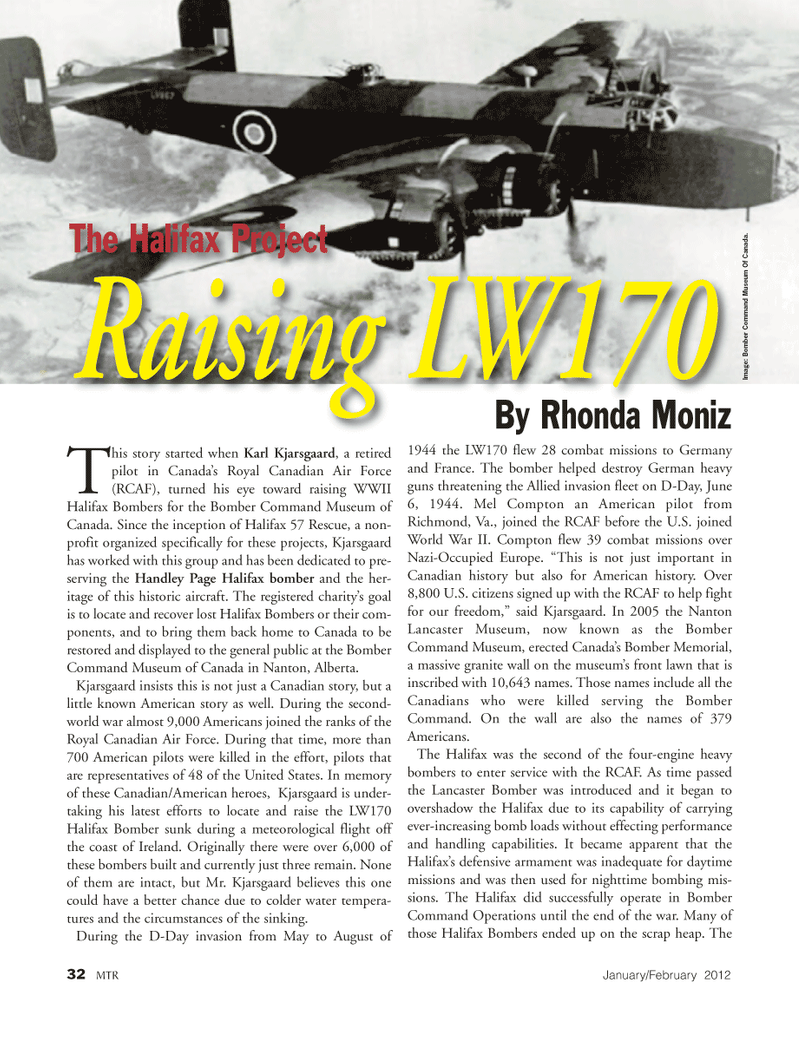
Page 32: of Marine Technology Magazine (January 2012)
Offshore Inspection, Repair & Maintenance
Read this page in Pdf, Flash or Html5 edition of January 2012 Marine Technology Magazine
32MTRJanuary/February 2012 The Halifax Project Raising LW170 By Rhonda MonizThis story started when Karl Kjarsgaard , a retired pilot in Canada?s Royal Canadian Air Force (RCAF), turned his eye toward raising WWII Halifax Bombers for the Bomber Command Museum of Canada. Since the inception of Halifax 57 Rescue, a non- profit organized specifically for these projects, Kjarsgaard has worked with this group and has been dedicated to pre- serving the Handley Page Halifax bomber and the her-itage of this historic aircraft. The registered charity?s goal is to locate and recover lost Halifax Bombers or their com- ponents, and to bring them back home to Canada to berestored and displayed to the general public at the Bomber Command Museum of Canada in Nanton, Alberta. Kjarsgaard insists this is not just a Canadian story, but a little known American story as well. During the second- world war almost 9,000 Americans joined the ranks of theRoyal Canadian Air Force. During that time, more than 700 American pilots were killed in the effort, pilots that are representatives of 48 of the United States. In memory of these Canadian/American heroes, Kjarsgaard is under- taking his latest efforts to locate and raise the LW170 Halifax Bomber sunk during a meteorological flight off the coast of Ireland. Originally there were over 6,000 of these bombers built and currently just three remain. None of them are intact, but Mr. Kjarsgaard believes this one could have a better chance due to colder water tempera- tures and the circumstances of the sinking. During the D-Day invasion from May to August of 1944 the LW170 flew 28 combat missions to Germany and France. The bomber helped destroy German heavy guns threatening the Allied invasion fleet on D-Day, June 6, 1944. Mel Compton an American pilot from Richmond, Va., joined the RCAF before the U.S. joined World War II. Compton flew 39 combat missions over Nazi-Occupied Europe. ?This is not just important in Canadian history but also for American history. Over 8,800 U.S. citizens signed up with the RCAF to help fight for our freedom,? said Kjarsgaard. In 2005 the Nanton Lancaster Museum, now known as the Bomber Command Museum, erected Canada?s Bomber Memorial, a massive granite wall on the museum?s front lawn that is inscribed with 10,643 names. Those names include all the Canadians who were killed serving the Bomber Command. On the wall are also the names of 379 Americans. The Halifax was the second of the four-engine heavy bombers to enter service with the RCAF. As time passed the Lancaster Bomber was introduced and it began to overshadow the Halifax due to its capability of carrying ever-increasing bomb loads without effecting performance and handling capabilities. It became apparent that the Halifax?s defensive armament was inadequate for daytime missions and was then used for nighttime bombing mis-sions. The Halifax did successfully operate in Bomber Command Operations until the end of the war. Many of those Halifax Bombers ended up on the scrap heap. The Image: Bomber Command Museum Of Canada.MTR#1 (18-33):MTR Layouts 1/4/2012 3:53 PM Page 32

 31
31

 33
33
